
Guide to Banana Connectors - Plugs & Sockets
Banana plugs are spring-loaded, single-wire (conductor) electrical test connectors used for joining wire to electrical equipment or electrical circuit boards. Banana connectors come in two forms, a banana plug or a banana socket. The banana plugs directly into a banana socket (often referred to as a banana jack). Popular testing equipment and test accessories such as leads and cables use a banana connection. A banana plug is considered a male connector and is called a banana because of its unique contact tip. The banana plug is a cylindrical pin that has “metal-leaves” that bulge outward to produce a strong connectivity contact (snug fit) in a socket to prevent the pin from disconnecting or falling out. Banana plugs often connect to wire that can be soldered, crimped, or screwed into place. Many banana plugs are also available as adapters, offering a plug to another connection style.
As with all things, there are tons of banana plugs out there offering different combinations and styles or features used for testing equipment and other applications. Each style is for use with different voltages and applications, often to personal preference or equipment requirements. E-Z-Hook is happy to provide a guide to what those banana plug features are, when to use them, and which E-Z-Hook part is compatible for your specific testing requirements. We offer individual connectors as well as banana plug test leads and banana plug cable assemblies. This enables users to create their own DIY (do-it-yourself) components or to provide users with already assembled test leads and cables.
Features / Styles of Banana Plugs
- Standard and Miniature Styles
- Contact Tip Design - 4 or 9 Leaves
- Protective Sleeve - Shrouded, Unshrouded, or Shrouded Retractable
- Straight or Right-Angle Design
- # of Plugs - Single or Double
- Stacking or Non-Stacking Styles
- Banana Plug Adapters
Why are Banana Plugs Popular?
Popular and common connectors for electrical testing equipment
Plugs “leaf style” provides a secure contact into a socket for more reliable testing
Multiple styles to chose from based on user requirements and preference
Connectors plug and unplug easily, saving time
Size
Standard or Mini
Banana plugs come in various sizes, most commonly standard and miniature. A standard banana plug often refers to a 4 mm banana plug, especially in Europe. All E-Z-Hook standard banana plugs are compatible to a 4 mm banana socket. A mini (miniature) banana plug is a smaller version of the standard banana plug. They may very in size so understanding your connection requirement or diameter is important. More common miniature banana plugs measure between 3 mm and 2 mm. It is important to understand that the overall diameter of the plug tip does not measure exactly 2 or 4 mm, but it implies that the banana plug fits into that size socket.
Banana plugs are popular components across many fields for electrical testing and creating connections. For most industrial applications a standard banana plug size is used, but occasionally a smaller miniature banana plug size is required. In automotive diagnostics, most digital multimeters (DMM) use banana plug test leads in conjunction with the sockets integrate into the design of the DMMs. Many other pieces of equipment are designed with integrated banana sockets. You will find banana plugs used to connect low power circuits, speaker cables, and model railway applications. They are also popular in medical equipment and technician test kits in both the telecom and energy fields.
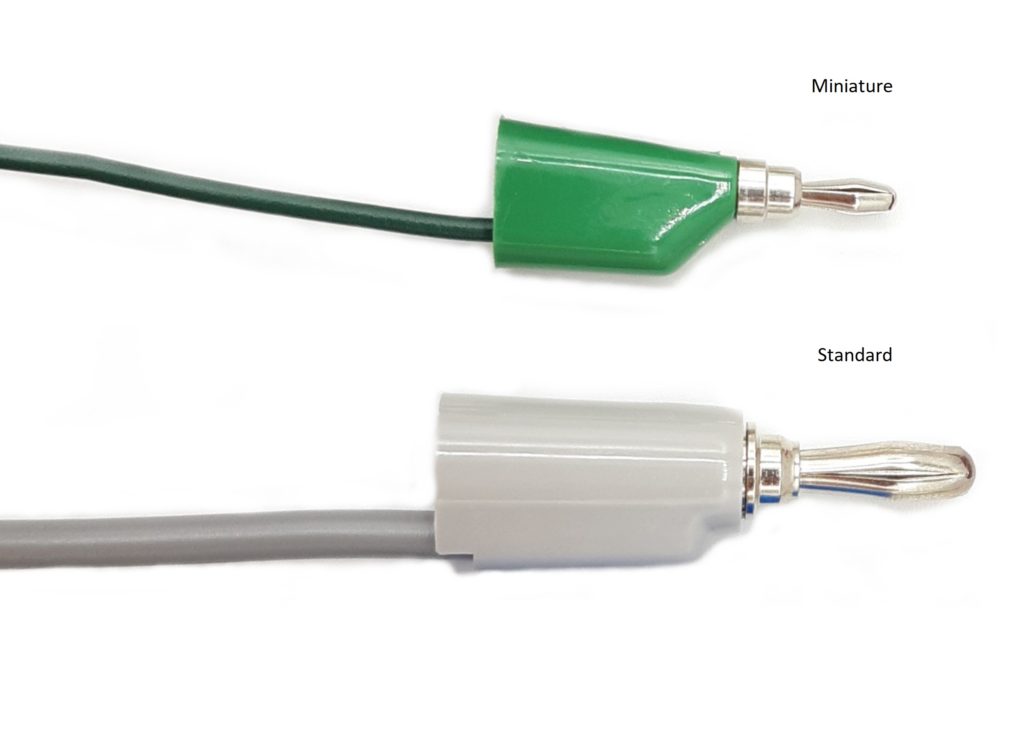
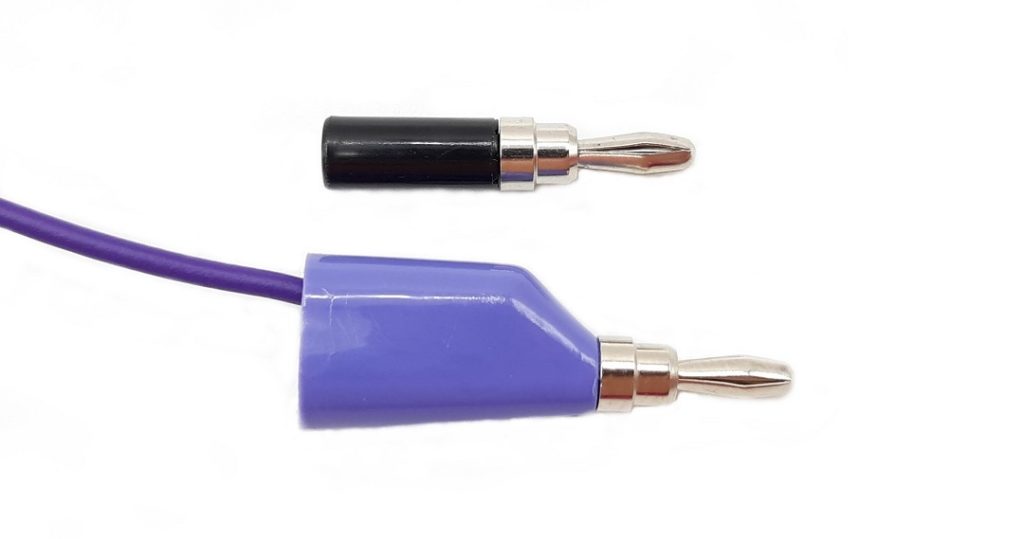
Contact Tip

Leaves
Banana plug contact tips are designed with “leaves” or protruding metal that bulges out and curves like a banana leaf. Most commonly used banana plugs have either a 4 or 9 leaf design. The protruding leaves plug into a banana socket (banana jack) and hold it securely in place. The majority of E-Z-Hook parts utilize 4 leaf banana plugs, however we do offer some plugs with the 9 leaf style.
4 Leaves Tip
The “4-leaf” plug has 4 metal-leaves that curve from the base to the top like a banana and is a popular styles for both standard and miniature banana plugs. This connector style is still considered the original or standard design style and most common in the United States.
9 Leaves Tip
The “9-leaf” plug has 9 metal-leaves that bulge outward from the middle of the pin and has a covered tip. This connector style was originally more common in Europe but is now equally prevalent. Both styles provide the same form, fit and function.
Protective Sleeve
Types
There are three common banana plug styles in regards to protective sleeving: shrouded, unshrouded, and retractable shrouded. The original banana plug was built as an unshrouded (also called unsheathed) banana plug. Shrouded (also called sheathed) banana plugs have a covering over the metal pin for safety requirements that are often required, especially in high voltage environments.
Unshrouded
An unshrouded banana plug is an unsheathed plug that features a bare metal pin that is uninsulated (no protective plastic sleeve around the connector) and visible. This type of banana plug is common for use in lower voltage (30-70 VDC) electrical testing applications. An unshrouded banana plug will fit in both a shrouded and unshrouded banana socket.
Shrouded
A shrouded banana plug is a sheathed banana plug with insulation (protective plastic sleeve) around the connector to avoid accidental contact with the metal plug. This is a common requirement in higher voltage applications (like CAT II and IV (600-1000 V) applications). Shrouded banana plugs will only fit into shrouded banana sockets (jacks).
Retractable Shrouded
The middle solution to shrouded and unshrouded plugs is a retractable sleeve banana plug (retractable shrouded banana plug) that has a spring-loaded shroud cover that slides out of the way when inserting the plug. These will work in both a shrouded or unshrouded banana sockets. The shroud cover slides back when the plug inserts into an unshrouded banana socket. This provides the benefit of shrouded protection but with the versatility of an unshrouded banana plug. The sleeve itself can be either clear or a solid color that matches the housing unit of the banana plug.
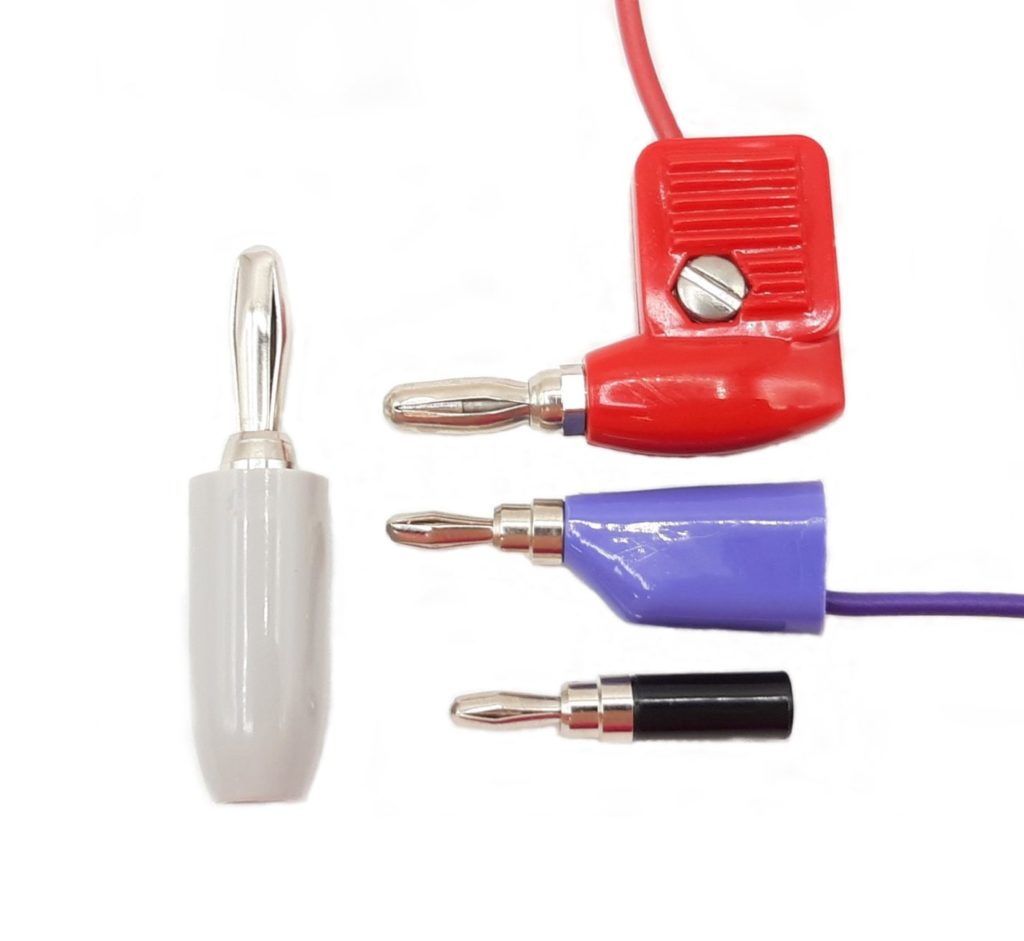
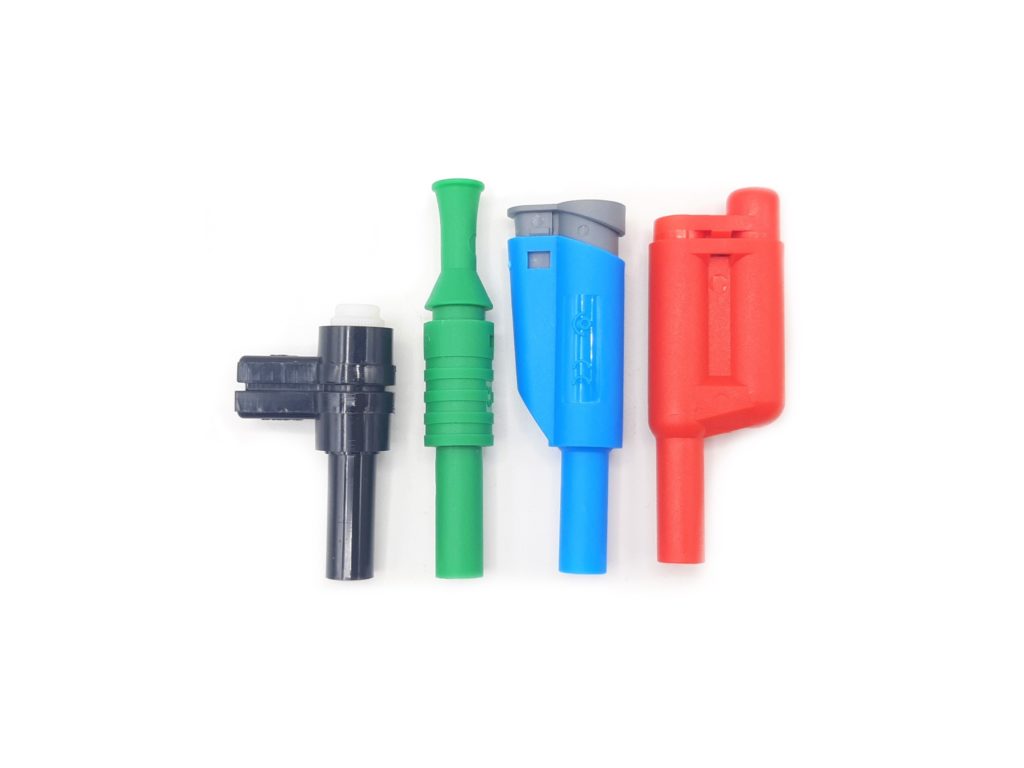
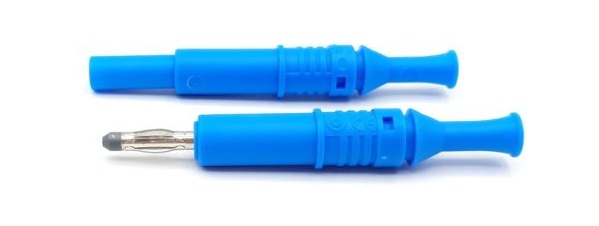
Connector Body Design
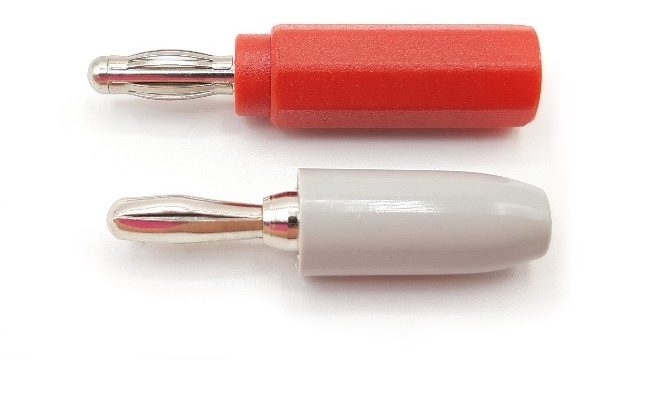

Straight vs Right-Angle
Banana plugs usually feature wire exit holes that are straight behind the housing unit at approximately a 180° or at a 90° right-angle.
Straight
Straight banana plugs are typically on patch cords or test leads for electronic test equipment, speaker wires, and probe leads or as adapters or connectors on binding posts. This style is easy to plug and unplug quickly, especially when connected as a lead.
Right-Angle
Right-angle banana plugs are the go-to style for use with digital multimeters (DMMs). Many people prefer the right-angle style, feeling it ensures a more secure connection that is less likely to dislodge due to wire or cable pull.
Multiple Connections at Once
Stacking
Stacking (stackable) banana plugs are banana plugs with a wire exit as well as a banana socket in the housing unit. This stacking socket is often designed on the back but stacking banana sockets can also be on the side, or in some cases both the back and the side. This stacking feature allows an additional banana plug of the same diameter to connect into the same connection point. Stacking banana plugs often act as patch cords (jumpers), on test leads to join multiple leads together to make shunts or connections to multiple places at once, or to extend testing length. They offer reliable and versatile electrical testing solutions for creating complex wiring kits or circuits by stacking multiple banana plugs on top of each other.
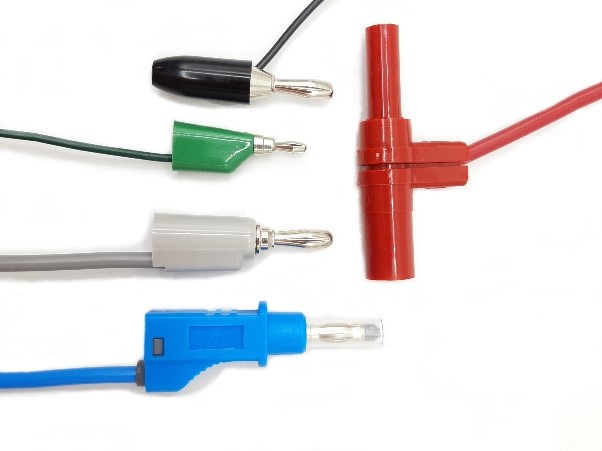
Double (Dual) Banana Plugs
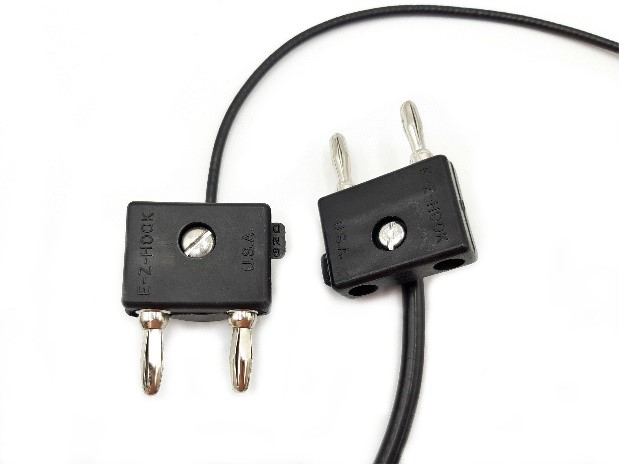
Double or Dual Banana Plugs
Double banana plug (or dual banana plug) is 2 banana plugs housed together in a single unit, often with 2 banana sockets and a single wire or cable exit hole. This type of plug is designed to make it safe to plug in 2 wires without creating a short across contacts. These type of connectors are available stackable (stacking double banana plugs) to provide continuous connection to multiple places. E-Z-Hook manufactures both standard and miniature double banana plugs. Customized double banana plugs are available with a shorting link or even a resistor if required. The image to the right shows a double banana plug coaxial cable jumper.
What Banana Plugs Plug Into
Banana Sockets (Jacks)
A banana socket (also called banana jack) is the electrical female connector that a banana plug inserts into to make a connection. Frequently found in automotive diagnostics, mounted on panels of industrial and electrical equipment, within digital multimeters, and other testing equipment to join the test leads to the equipment or circuit board. Like banana plugs, most common banana sockets remain manufactured in standard (4 mm) and miniature (2 mm) sized sockets. A standard banana sockets accept both the “4 leaf” and “9 leaf” banana plugs and accept unshrouded or retractable sleeve plugs, but do not have the capability to accept shrouded banana plugs. A shrouded banana socket can accept shrouded, unshrouded, and retractable sleeve banana plugs. Banana sockets are common electrical connectors for use in many different electrical applications. E-Z-Hook manufactures many styles of banana socket connectors as well as banana socket adapters.
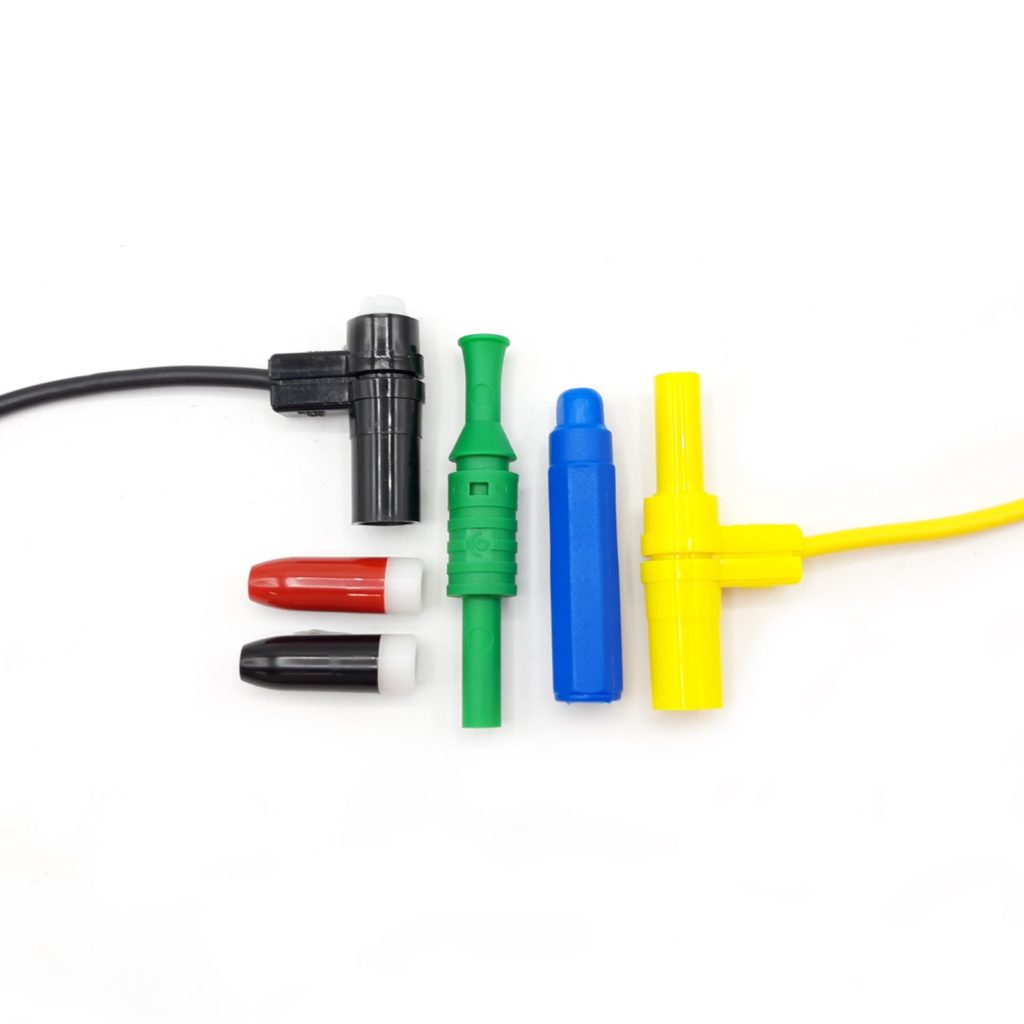
Banana Plug & Banana Socket Adapters
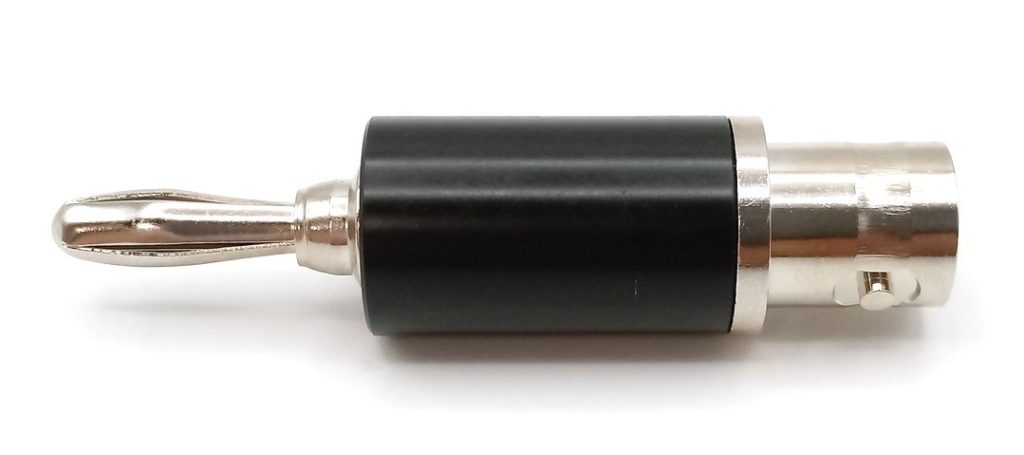
Banana Connector Adapters
The banana plug and banana socket adapters feature either a banana plug or socket to another connector which could be a banana plug or socket, pin plug or socket, coaxial connector, alligator (crocodile) clip, spade lug, nail clip (test terminal), test hook, probe or binding post. These banana connector adapters provide users the capability to change (or adapt) from one style of connection to another.
Many thanks for your email. Can you give us the plugs prices? Best regards.
Mr. Silva, Thanks for reaching out. I will send over the price sheet for our banana plugs and adapters in Excel format. If you require a different format or have any other requests, please feel free to email info@e-z-hook.com and we will be happy to assist you further!
I recently had a bad experience with a 4 leaf banana plug I use for speakers. The tip came off while unplugging. to my surprise the center rod of the tip and 4 leaf spring are just push fit into the body of the plug. Only a couple of mm contact between the springs and body. The center rod of tip is only for strength not for carrying signal.
Resources this kind of as the one you mentioned right here will be extremely helpful to myself! Ill publish a hyperlink to this page on my personal blog. I am positive my site guests will uncover that very useful.
You completed a number of fine points there. I did a search on the topic and found most folks will go along with with your blog.
Hello mate, I just wanted to tell you that this article was actually helpful for me. I was fortunate to take the tips you actually so kindly shared and even put it to use. Your web blog article truly aided me and i also would like to inform your dedicated audience that they really have someone that has her or his thoughts fixed. Thank you once more for the excellent posting. I’ve truly bookmarked this on my favored online bookmarking web site and i also recommend everyone else do the very same.
I have NAD D3020. The banana does not go fully home, the socket is too shallow. Can you get shorter plugs?
This article has been really handy.
I accidentally got dual banana plugs in a plastic separator and I thought at first it was silly extra packaging until I seen the reason . Thank heavens I did not damage the gold plating by trying to remove them from the plastic with pliars – thanks for this article 🙂
Great writer, Thanks for delivering the outstanding blog. I found it informative. Best regards !!
Thank You for Sharing this informative article! It is very useful to everyone. Stay healthy and keep safe!
Hello and thank you for your banana plug information. It is very helpful. I do have a further question regarding connecting mini to regular banana plugs. 1. Is it possible and are there such adapters? 2 What are the connection risks if any? and finally 3. What are the additional space requirements of an adapter? I’m working in a very small space which creates a new difficulty in my case. Many thanks. Rich
Very clear and good article easy to understand. Thank you.
It’s haгd to come by well-іnformed people for this subject, however, you seem liҝe you know what you’re talking about! Thanks.